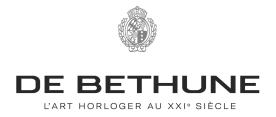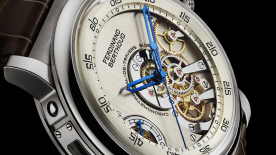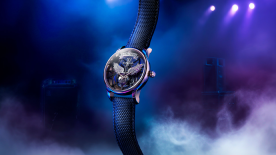Looking at a watch is a fascinating exercise, filled with different emotions and sensations. You take it in your hand and weigh it in your palm. You run your fingers over the case and feel its curves and its angles. You bring the dial up to your face to admire its colours, its shapes and its contrasts.
And then you turn it over. Closed back or sapphire? There will be various arcane inscriptions and references. Letters and numbers. And then, of course, there’s the movement, the heart and soul of a timepiece. Decorated, simple, complicated, silent or noisy – it draws the gaze and holds the attention.
This tactile and visual experience wouldn’t be complete without strapping it to your wrist, to see how it looks. This is an important moment, because a watch is an intimate object; it is worn next to the skin, where it becomes part of a style and defines, or emphasises, a personality.
Once on the wrist, it’s also possible to feel how comfortable the strap or bracelet is, see how it drapes around the wrist, assess its weight and get some reassurance about the size.
And that’s it – you either like it, or you don’t. And yet, in this brief description of the meeting between an object and a person, I’ve left out one vital element. It’s the reason the watch exists – the reason without which it would not be. I’ve omitted to mention the purpose of the movement, the ultimate objective of the hundreds of tiny components inside, all working together.
I’ve forgotten to mention the hands. Without hands, there’s no watch. Without hands, the movement has no point. Without hands, there’s no hours, minutes or seconds. Without hands, it’s difficult to know whether the watch is fast or slow, or if it’s even running at all.
It’s time to give this minuscule detail, this tiny but nevertheless crucial element of a watch, its due. In the beginning, there was a ray of sunshine. This ray of light gave life to the sundial. No hands – just a ray. It moved across the ground, and thus provided information.
Everything started here, with the use of a heavenly body to understand time. Hands appeared much later. Once Man understood that time could be mastered, he decided to give it meaning. One hand, two, then more... And on the basis of all this he built a mechanism: the movement. The aim was always the same: to control time and make it visible.
For hundreds of years, hands were the only way to tell the time. That was true of every country, every culture, and every era. The hand was the common tongue, the lingua franca, shared across the world.
And then we discovered the simplicity of actual numbers. Instead of deciphering the hands, all you had to do was read off the figures. The watch, driven by electronic or quartz movements, had finally come of age! It had begun to actually “tell” the time, and the days of the hand were numbered. We called it “modernity”. We could say goodbye to those tedious childhood drills with big hands and little hands. All you had to do was read.
The watch had become digital. It was the end of analogue, the end of a paradigm. And yet, despite the relentless march of progress, this tiny detail refused to disappear. And that’s the magic of history.
But it did begin to lose ground, taking refuge in antique or old-fashioned watches – those that would later be labelled “vintage”. (There is something of the David and Goliath in the story of the hand.) It fell out of favour, became obsolete, a reminder of a time we’d rather forget.
And yet, little by little, those screens with their blocky numbers began to lose their appeal. Yes, they were practical, but they weren’t all that... sexy. “Proper” watches, watches that had hands, were welcomed back to centre stage – more and more of them, more and more quickly.
And eventually they returned to the apex of the watchmaking pyramid, once again reigning over dials and movements.
But the threat had not totally disappeared.
Smartwatches were preparing their invasion. Even the name inspired fear: intelligent watches...?? This obviously implied that there were also “stupid” watches – watches with hands, mechanical watches, which once again became synonymous with all that is primitive and backward.
This new clever watch offered a big screen, bright colours, information and animation. It seemed as though the death knell had sounded for the humble hand. But wait... To the surprise of many, these intelligent watches also came with virtual dials and virtual hands. Rather than killing them off, the Californian behemoths had received the message loud and clear: if you can’t beat them, join them. To conquer hearts and minds... and wrists, killing the hand was not the answer. No, they had to win them over!
And so we have reached the point where the latest and greatest new feature of the new Apple Watch is its permanently illuminated screen. And in the centre of its digital screen, it has – hands.
Another battle is won: the hand has conquered the smartwatch.
Why De Bethune?
I’ve been looking for a watch to illustrate the story I just told for quite a long time now.
A watch that can speak of the past, but also the future. A piece that is both modern, yet crammed full of “antique” detail. I could have considered watches that are closely associated with particular styles of hands: Mercedes, Lollipop, cathedral, dauphine or sword. But the risk was that I’d be tempted to talk only about the past, to forget that hands are also the future of the watch. And that’s why I decided to talk about the De Bethune Maxichrono.
De Bethune is a young and dynamic brand, resolutely future-focused but with traditional underpinnings. Its small and passionate team has created a distinctive stylistic signature. A De Bethune has a unique design that’s recognisable from a mile away.
But beyond their design, De Bethune watches are also mechanical marvels, developed by exceptionally talented master watchmakers. The brand based in the canton of Vaud in Switzerland never stops innovating and launching new calibres.
The company has launched almost as many new movements as it has staff members – that’s 27 manufacture movements, and 30 employees! In a world that thrives on data and figures, this is an exceptional ratio! De Bethunes are exceptional, rare and rewarding. They are a bridge between old and new. They are beautiful and intelligent, but above all, they give pride of place to the hands.
Above and beyond the mechanical complication, De Bethune lends great meaning to these tiny components that are so often overlooked. The hands of a De Bethune are sophisticated, original and impossible to ignore. Clearly, the company’s watchmakers didn’t forget them. Quite the opposite. Their role is paramount. And this is particularly true of the Maxichrono that I will talk about next.
The De Bethune DB21 Maxichrono Réédition
The chronograph is one of the most popular complications. It’s also the complication that allocates the most real estate to hands. Knowing De Bethune, it’s not surprising that they should choose to explore new dimensions with this complication. This watch is the result of that exploration. It was initially launched in 2006, with a relaunch a few years later.
The great success of the Maxichrono lies in its apparent simplicity. Chronographs are traditionally recognisable by their multiple dials and subdials. There’s none of that here.
The DB21 Maxichrono places the hands in the centre of the dial, rather than farming them out to subsidiary registers. It’s simple, effective, and fiendishly difficult to achieve! To begin to understand the complexity of this watch, you can start by counting the hands: 1, 2, 3, 4, 5... all on the same axis. And then get your head around the fact that they are all driven, and adjusted, separately.
This meant designing a revolutionary hand-wound movement with over 420 parts, which has a power reserve of 5 days! But the exceptional qualities of this timepiece don’t stop at the simplicity of the display and the superposition of hands.
A classic chronograph has another feature: push pieces. There are often two of them, plus an adjusting crown. Again, you can forget all that. The De Bethune DB21 Maxichrono is a monopusher chronograph. So, while the hands have multiplied, the pushers have disappeared. This underlines the deceptively simple aesthetic of the piece. But once again, De Bethune’s team brought a touch of originality to this single pusher, which has been moved to 6 o’clock (where it is located on some vintage dive watches).
But the stylistic exercise doesn’t stop there. The next step is the case.
Welcome to the future. The case is utterly unique. The movement is nestled inside a titanium case which is cradled between floating lugs. This means that the case can mould to the shape of your wrist. Once again, the idea is simple, the implementation complex, and the result magnificent.
But let’s get back to our hands. There are five of them, all with their own different styles. Thick, thin, coloured – this abundance of shapes could create chaos, but it doesn’t. They are all singing from the same chronographical song sheet, and the differences don’t jar at all. Quite the opposite.
With this Maxichrono, De Bethune has created a magnificent Ode to the Hand. The watch is close to perfection, but our Devil’s Advocate is hovering... what does he think?
The opinion of the Devil’s Advocate
With De Bethune, it’s all about order and beauty, luxury, peace and pleasure! In short – everything the Devil hates! But seriously, what more could we ask of the DB21?
The first minor detail is that its price (CHF 155,000) and limited number (5 pieces) make this watch virtually unobtainable. De Bethune offers an identical complication in the DB 28 range, with a slightly modified design, but at a similar price point.
The second element that merits discussion is the flexible blue cradle. I love this detail, but I understand that it might upset the more conservative among us, or put off people who are concerned they might get tired of the colour.
My third and final point is its limited (virtually non-existent) water resistance. Yes, the Maxichrono is a grand complication watch, but its sporty appearance suggests that it might lend itself to the occasional nautical outing. But it doesn’t, so please be careful.
Wearing the De Bethune DB21 Maxichrono with style
As winter approaches, let’s look at how we can combine this epic chronograph with a simple outfit that makes the most of its exquisite details.
Cooler weather means it’s time to break out that corduroy jacket, or even a corduroy suit.
I like the way this fabric looks when it’s worn, and especially the patina it acquires with age. My choice would be a Vicomte A suit in dark blue corduroy. Braver souls might opt for the orange version, which is fabulous but hard to pull off every day! A mismatched jacket would work equally well – denim, perhaps, or one in pine green twill from the same brand.
On your feet, why not leave your classic loafers and your sneakers at home, and go for lace-up boots, which will ensure your outfit doesn’t take itself too seriously. I have a preference for the Higgins boot in Cordovan by Allen Edmonds, whose patina will be a good match for the casual vibe of the blue cord. If you prefer a dressier look, you might choose a pair of Daltons, also in Cordovan, in the famous Colour 8 (dark burgundy). Cordovan leather is probably one of the finest materials for footwear, but you have to understand its foibles, and be ready to roll with any irregularities or colour differences you might find within the same pair.
The shirt could be chambray or, even better, thick flannel.
And finally, don’t forget your scarf. Cashmere, obviously. I would be tempted to pick a Berluti in the Scritto pattern, brown, to complete the autumnal look.






